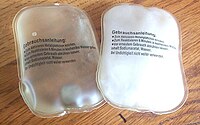
Photo from wikipedia
Syntactic foams (SFs) combining an epoxy resin and hollow glass microspheres (HGM) feature a unique combination of low density, high mechanical properties, and low thermal conductivity which can be tuned… Click to show full abstract
Syntactic foams (SFs) combining an epoxy resin and hollow glass microspheres (HGM) feature a unique combination of low density, high mechanical properties, and low thermal conductivity which can be tuned according to specific applications. In this work, the versatility of epoxy/HGM SFs was further expanded by adding a microencapsulated phase change material (PCM) providing thermal energy storage (TES) ability at a phase change temperature of 43 °C. At this aim, fifteen epoxy (HGM/PCM) compositions with a total filler content (HGM + PCM) of up to 40 vol% were prepared and characterized. The experimental results were fitted with statistical models, which resulted in ternary diagrams that visually represented the properties of the ternary systems and simplified trend identification. Dynamic rheological tests showed that the PCM increased the viscosity of the epoxy resin more than HGM due to the smaller average size (20 µm vs. 60 µm) and that the systems containing both HGM and PCM showed lower viscosity than those containing only one filler type, due to the higher packing efficiency of bimodal filler distributions. HGM strongly reduced the gravimetric density and the thermal insulation properties. In fact, the sample with 40 vol% of HGM showed a density of 0.735 g/cm3 (−35% than neat epoxy) and a thermal conductivity of 0.12 W/(m∙K) (−40% than neat epoxy). Moreover, the increase in the PCM content increased the specific phase change enthalpy, which was up to 68 J/g for the sample with 40 vol% of PCM, with a consequent improvement in the thermal management ability that was also evidenced by temperature profiling tests in transient heating and cooling regimes. Finally, dynamical mechanical thermal analysis (DMTA) showed that both fillers decreased the storage modulus but generally increased the storage modulus normalized by density (E′/ρ) up to 2440 MPa/(g/cm3) at 25 °C with 40 vol% of HGM (+48% than neat epoxy). These results confirmed that the main asset of these ternary multifunctional syntactic foams is their versatility, as the composition can be tuned to reach the property set that best matches the application requirements in terms of TES ability, thermal insulation, and low density.
Journal Title: Polymers
Year Published: 2021
Link to full text (if available)
Share on Social Media: Sign Up to like & get
recommendations!